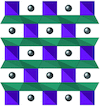issue contents
January 2021 issue

Cover illustration: N-Salicylidene-p-aminobenzoic acid crystals undergo a two-step gas–solid reaction with aqua–ammonia vapour in the crystalline state. Moreover, the photochromic behaviour of the crystals was switched from OFF to ON and back to OFF through a phase transformation. See Sugiyama & Uekusa [Acta Cryst. (2021), C77, 56–60].
research papers
Download citation


Download citation


The new quaternary thiosilicate, Li2PbSiS4 (dilithium lead silicon tetrasulfide), crystallizes in the noncentrosymmetric stannite structure type and belongs to a large family of severely compressed chalcopyrite-like compounds. The structure features a relatively regular SiS4 tetrahedron, a flattened LiS4 tetrahedron, and a distorted PbS8 dodecahedron. Electronic structure calculations using density functional theory indicate that the yellow compound is an indirect bandgap semiconductor.
CCDC reference: 2045042
Download citation


Download citation


Five new 1-benzoyl-3-(halogenophenyl)thioureas have been synthesized and characterized. Hydrogen bonding, molecular conformations and intermolecular interactions have been examined in detail. The structures are described in comparison to related previously described 1-benzoylthioureas.
Download citation


Download citation


Two conformational polymorphic structures of dipharmacophore 3-cyclopropyl-5-(3-methyl-[1,2,4]triazolo[4,3-a]pyridin-7-yl)-1,2,4-oxadiazole have been studied in detail using both X-ray diffraction and quantum chemical calculations. Stacking interactions of different types are strongest in the two crystals. In addition, the polymorphic structures differ with regard to the type of main structural motif of the crystal packing, which is a double column in the monoclinic structure and a single column in the orthorhombic structure.
Download citation


Download citation


The semirigid organic ligand 4-{2-[(pyridin-3-yl)methyl]-2H-tetrazol-5-yl}pyridine, with tetrazole and pyridine fragments, has been used successfully to prepare coordination complexes with ZnII salts. The ligand displays different conformations during the process of constructing coordination complexes. The results indicate that the selection of different counter-anions and different solvents plays an important role in the construction of various coordination complexes and has an important effect on the fluorescence properties through the hydrogen-bonding system and weak C—Cl⋯π or π–π interactions.
Download citation


Download citation


Methyl 4-amino-3-phenylisothiazole-5-carboxylate, being a close analogue of amflutizole, was used to study the capability of isothiazole to form polymorphic structures. The application of experimental methods and quantum chemical calculations allowed an indication of the differences in the crystal packing of the noncentrosymmetric structure obtained due to faster crystallization and the centrosymmetric structure formed due to slower crystallization from a denser solvent.
Download citation


Download citation


The structures of two cocrystals of trithiocyanuric acid with 2,2′-bipyridyl and 4-methylbenzohydrazide have been determined. In the crystalline state, the molecular components are linked by N—H⋯S hydrogen bonds, forming ![[R_{2}^{2}]](/c/issues/2021/01/00/dg3012/teximages/dg3012fi1.svg) (8) synthons. The observed tautomerism of trithiocyanuric acid was characterized by quantum chemistry methods.
(8) synthons. The observed tautomerism of trithiocyanuric acid was characterized by quantum chemistry methods.
Download citation


Download citation


N-Salicylidene-p-aminobenzoic acid crystals undergo a two-step gas–solid reaction with aqua–ammonia vapour in the crystalline state. Moreover, the photochromic behaviour of the crystals was switched from OFF to ON and back to OFF through a phase transformation.
CCDC reference: 2051277

 journal menu
journal menu
























